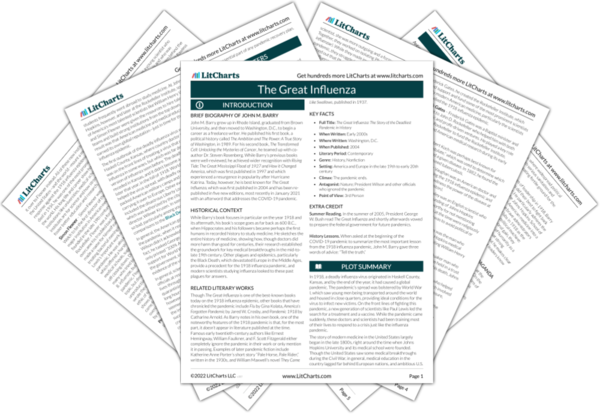John Barry’s The Great Influenza is about leadership’s ability to change the course of a crisis, both for better and for worse. In 1918, the world faced two related crises: an influenza epidemic that killed staggering numbers of people in a relatively short period of time, and World War I, which was the deadliest conflict that modern Europe had ever seen. Barry argues that much of this destruction, both in the war and in the pandemic, was made worse by bad leadership. For example, he criticizes President Woodrow Wilson for refusing to acknowledge the pandemic in public statements, sowing doubt and confusion as people saw evidence of a Black Death-like disease with their own eyes. Moreover, Wilson took a very individualistic approach to international diplomacy, almost single-handedly navigating America’s role in the World War I peace negotiations. This backfired when Wilson fell seriously ill, causing him to act erratically and leading to a deeply flawed peace treaty that set the stage for World War II. Other leadership failures happened on a smaller scale but were just as significant. Barry looks in particular at Philadelphia, where widespread political corruption left the city with serious sanitation and overcrowding problems, creating fertile ground for the influenza epidemic.
Still, in spite of the many failures of leadership in 1918, Barry also highlights how some leaders did their best to fight back against the pandemic and the war. He particularly admires the skilled leaders who helped found the Johns Hopkins School of Medicine and who helped transform American medicine into a major global player. Barry portrays the brave administrators and scientists who ran universities and labs in 1918 as the opposite of Wilson and the Philadelphia political machine: instead of working individually or for personal gain, they worked with collaboratively for the benefit of humanity as a whole. In The Great Influenza, Barry argues that strong leadership is the best way to combat a crisis, but he makes clear that “strong” doesn’t mean dictatorial—the best leaders know how to collaborate and communicate.
Leadership and Crisis ThemeTracker

Leadership and Crisis Quotes in The Great Influenza
The Great War had brought Paul Lewis into the navy in 1918 as a lieutenant commander, but he never seemed quite at ease when in his uniform. It never fit quite right, or to sit quite right, and he was often flustered and failed to respond properly when sailors saluted him.
Nothing about the boyhood or youth of William Henry Welch suggested his future.
In the spring of 1918 death was no stranger to the world. Indeed, by then the bodies of more than five million soldiers had been fed into what was called the “sausage factory” by generals whose stupidity was matched only by their brutality.
Wilson had demanded that “the spirit of ruthless brutality. . . enter into the very fibre of national life.” To carry out that charge, Creel had wanted to create “one white-hot mass,” a mass driven by “deathless determination.” He was doing so. This was truly total war, and that totality truly included the medical profession.
As the virus moved, two parallel struggles emerged.
One encompassed all the nation. Within each city, within each factory, within each family, into each store, onto each farm, along the length of the track of the railroads, along the rivers and roads, deep into the bowels of mines and high along the ridges of the mountains, the virus would find its way. In the next weeks, the virus would test society as a whole and each element within it. Society would have to gather itself to meet this test, or collapse.
The other struggle lay within one tight community of scientists. They—men like Welch, Flexner, Cole, Avery, Lewis, Rosenau—had been drafted against their will into a race.
The Liberty Loan campaign would raise millions of dollars in Philadelphia alone. The city had a quota to meet. Central to meeting that quota was a parade scheduled for September 28.
Two days after Philadelphia’s Liberty Loan parade, Wilmer Krusen had issued that somber statement, that the epidemic in the civilian population “was assuming the type found in naval stations and cantonments.”
Lewis knew full well that little of what he was doing was good science. It was all, or nearly all, based on informed guesswork. He only worked harder.
As he worked, the society about him teetered on the edge of collapse.
While science was confronting nature, society began to confront the effects of nature. For this went beyond the ability of any individual or group of individuals to respond to. To have any chance in alleviating the devastation of the epidemic required organization, coordination, implementation. It required leadership and it required institutions follow that leadership.
By World War I, the revolution in American medicine led by William Welch had triumphed. That revolution had radically transformed American medicine, forcing its teaching, research, art, and practice through the filter of science.
So the final lesson of 1918, a simple one yet most difficult to execute, is that those who occupy positions of authority must retain the public’s trust. The way to do that is to distort nothing, to put the best face on nothing, to try to manipulate no one.











